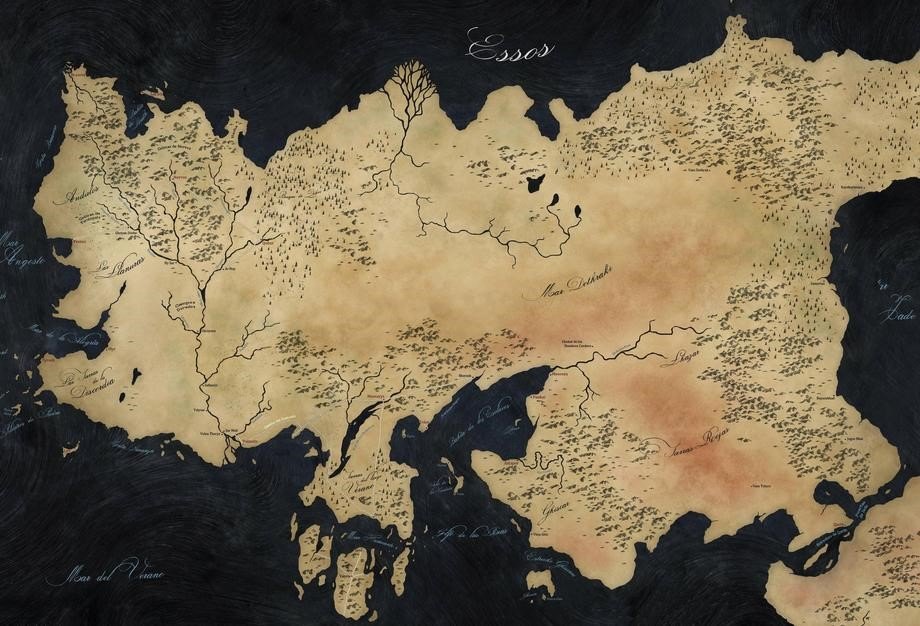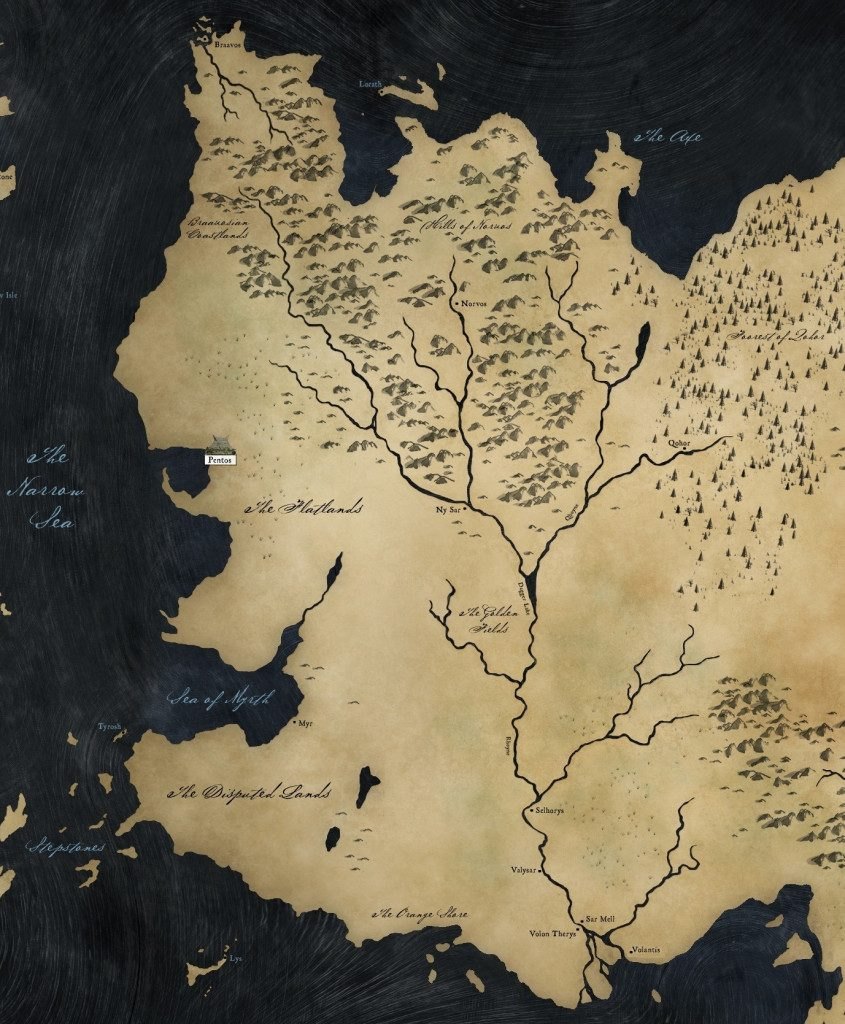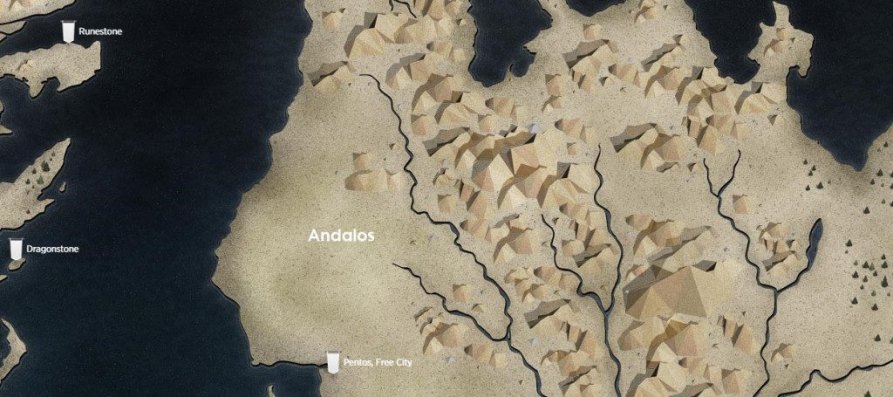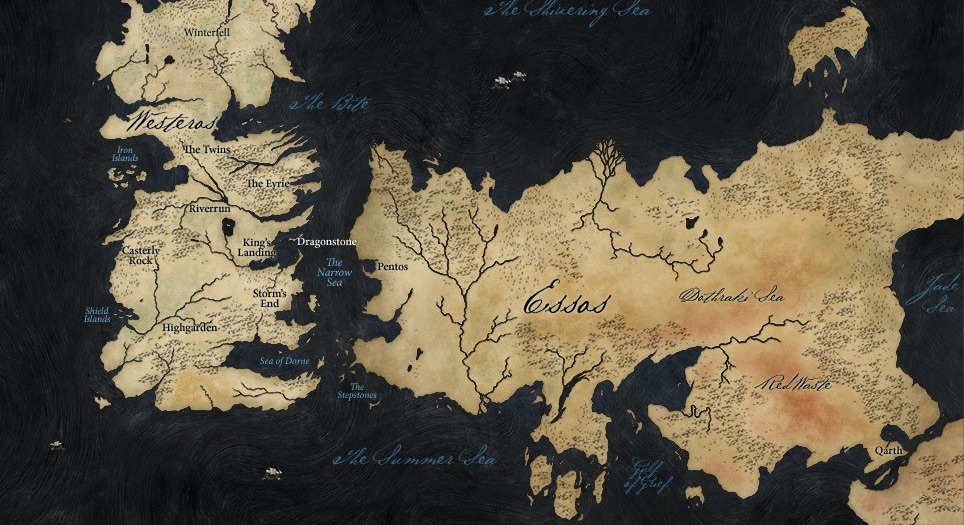The strength of any fantasy story, especially medieval, stems from the world it creates and the characters that inhabit it. Fortunately for us, ‘Game of Thrones’ proves its mettle on both of these by introducing a world that is quite fantastic beyond our imagination, and full credits to writer George R.R. Martin for that. In fact, the only other fantasy series that I can think of, one that can even give ‘Game of Thrones’ a run for its money when it comes to sheer ambition, scope and execution and the grandiosity of stories told is Peter Jackson’s ‘The Lord of the Rings’ film series, and unsurprisingly so, most of the winning factors of the original trilogy stem from the two things that I have mentioned, providing the canvas for the legends and myths that unfurl in the story’s wake that makes these films/TV series so entertaining to watch.
While the most popular show on this planet airs its final season with showdowns and battles galore, we thought it would be a good exercise to go back to recapitulating what the fictional ‘Game of Thrones’ world looked like, and the royal families that ruled out of them. Of course, the setting for the action has narrowed over the course of the seasons to the surviving families contending for the throne and their strongholds, but when the series began, ‘Game of Thrones’ could easily pride itself on the sheer vastness of the fictional world it displayed.
Much like our little blue planet here, the geographical divisions pave the way for a host of different people, different cultures, different living conditions and even vastly different climates, that allowed this show to sustain probably the largest cast of characters over eight seasons, and warrant the budget, apart from the CGI on dragons of course. For now though, I hope you are ready for a discourse in geography. Word to the wise, I do not seek to expand on the histories of the Andals and the First Men or the Children of the Forest, leave alone how the seven kingdoms came to be. This write-up is going to explore more of the regions’ present divisions and consequences. Read on.
Introduction to the Map: Continents

George R.R. Martin has spent a considerable and admirable amount of time in setting up the regions and the fictional histories of each of them in his fantasy tale. As it turns out, when you take a look at the map of Martin’s ‘A Song of Ice and Fire’ world, you will see that Westeros (where majority of GoT is set) occupies less than a fourth of the total area of the landmass. The largest continent in this world would be Essos, separated from Westeros by the Narrow Sea, with the East beyond the Bone Mountains and The Southern continents left particularly unexplored, even in GRRM’s books. This was apparently done to further reflect how little the Westeros people knew or thought of the world outside the Seven Kingdoms. As we have our four major regional distinctions, we have a direction to proceed in to expand on what places these occupy on the map.
Essos

The largest continent on the map of ‘The Known World’, Essos’ closest cousin in the real world be Eurasia. Located to the East of Westeros and separated by the Narrow Sea, the western coast of the large landmass is dotted by the nine free cities, naval merchant towns known as such. The geographies of these regions vary from coastal cities to island states to further inland, flanked by forest and hill regions. The two historically most significant city states in Essos that played a major part in the shaping of the known world would be the ancient Andalos believed to be the home of the Andals, located next to these cities and the ruined Valyria, located south of the landmass in an isolated group of islands.
Towards the middle of the continent is a vast prairie flatland known as the The Dothraki Sea, sparsely inhabited by the tribal Dothraki with their stronghold at Vaes Dothrak. Further east is the arid barren wasteland known as The Red Waste, flanked a little to the Northeast by the biggest mountain range in the known world, called the Bone Mountains. This mountain range is what separates the relatively well known and documented western region of Essos from the almost completely unknown mystic region of the East. Now we begin to expand on which of these places had a part to play in the show itself.
The Free Cities

Looking at the naval proximities of most of the nine free cities of Essos, namelyLorath, Braavos, Pentos, Myr, Tyrosh, Lys, Volantis, Norvos and Qohor, it is easy to understand that all of them are active port cities with numerous intersecting trade routes, and places of culture with mercantile influences, except for Qohor that is mostly covered in forests and Norvos, which is situated inland. Not much is known about these two cities from the show, except their shared history with the rest of the free cities that proclaimed their independence from any kind of rule after the Doom of Valyria. Apart from some of the secondary characters on the show mentioned to be hailing from one of the free cities, the show has focused most of its attention on Braavos to the North, Pentos in the middle and Volantis in the south, all of them being coastal towns. Among the three, Braavos receives the most screentime, and is typically characterised on screen with a large statue of the Titan of Braavos right at its entrance bay.

The city was established as a refugee freehold against the rule of Valyria, and quickly developed to be the richest trade centre in all of the known world after its doom. It is most famously known as the place where Arya trains for the most part for several months in The House of Black and White in Season 5. Another notable mention of the city would be the Iron Bank of Braavos, that is famous for lending money to various empires of Westeros, and for providing Cersei with the loan to hire out the Golden Company, a group of sellsword mercenaries, brought to Westeros on Euron Greyjoy’s ships, minus the elephants, of course.

Coming to the other two, Pentos is where Daenerys’ journey begins, when she is married off to Khal Drogo near the mansion of Illyrio Mopatis, not far from the main city of Pentos. It is also the place where Tyrion lands after escaping in a barrel, seeking refuge after killing his father, accompanied by Varys, whereon the two proceed to Meereen to meet Daenerys to support her cause. Volantis, further southward, is the city Varys and Tyrion stop by on their way to Meereen, and also where Tyrion is kidnapped by the exiled Ser Jorah to be presented to Daenerys.
Valyria

Valyrian steel and its language have been prominent elements in the show, especially in the later seasons where Valyrian steel daggers, swords and dragonglass are tools termed capable of slaying White Walkers and Wights. The island nation was home to the Targaryen Dynasty that found its roots here before moving to Westeros following Aegon’s conquest, setting up his dominion over the seven kingdoms of Westeros.

The region was characterised by being dotted across the land with several volcanoes where a few dragon eggs were discovered by a group of subsistence farmers, who soon grew to become the most powerful men in all of the known world after they learned to tame dragons and use them in warfare, quickly expanding their rule and conquest to the far north of Essos, before an event termed as the Doom of Valyria rendered it an oblivion; when the active volcanoes on the island exploded, killing its populace and the dragons.
Andalos

Andalos’ history is even more significant when it comes to setting up the shared future of Westeros, although it is barely mentioned in the show. It is here that the Andals originated, along with the faith of the Seven: the Father, the Mother, the Maiden, the Crone, the Warrior, the Smith, and the Stranger. From here, the Andals moved to take over most of the kingdoms of the First Men in Westeros, and spread their faith. The region is characterised by hills and flatlands geographically, separating the coastal region and free cities of Essos from the Dothraki Sea and the lush forests of Qohor.
Slaver’s Bay

Among the lesser enlightened of the cities of Essos, we have the region infamously known as the Slaver’s Bay located to the South of Essos and flanked to the North by the Dothraki sea, and as the name suggests, is considered to be the hub of international slave trade. Geographically, the bay is formed by by the Gulf of Grief narrowing from the Summer Sea in the South.

The primary cities in the bay include Astapor, Yunkai and Meereen, all important stops in Daenerys’ journey as she moves to abolish slavery in the Bay and liberating the region before setting up a stronghold in Meereen, and renaming it as the Bay of Dragons, but only in the show. This is also where she departs from the Greyjoys’ fleet for Westeros at the end of Season 6.
Qarth

Qarth is a city in Southern Essos that makes an appearance in the Second Season of ‘Game of Thrones’, claimed to be the greatest city there ever was or will be, by one of its thirteen governing warlocks. Geographically, the city is walled and secured on three sides where it is surrounded by unending desert, and the fourth side being open to the sea for trade, making it one of the most prosperous cities in Essos.

Daenerys travels to Qarth when she and the Dothraki following her are famished and thirsty from travelling days across the red waste. They are initially denied entry by the warlocks, but are eventually allowed by Xaro Xhoan Daxos, who planned to kill the other warlocks after conspiring with another one, Pyat Pree, and seize Dany’s dragons for themselves, and we all know how that turned out.
Vaes Dothrak

Vaes Dothrak is the unofficial capital city of the Dothraki, who mostly live in tribes and nomadic settlements across the Dothraki Sea. Home to Khal Drogo and the Dosh Khaleen, the body of holy women and widows of Khals, Vaes Dothrak is located in the midst of the vast grassland that is the Dothraki Sea, and its entrance is marked by two large stallions.

It is an important trading centre with a market of its own, where Khals of other tribes often meet to settle disputes as well. Drawing weapons on a fellow Dothraki is forbidden inside Vaes Dothrak.
Westeros

Westeros is where the majority of the action from the series and the books takes place. The first inhabitants here were largely considered to be the Children of the Forest, whose origins are briefly touched upon in the series. They were the ones who carved the faces of the old gods into weirwood trees, like the one in Winterfell, known as the old gods. Later came the First Men, initially at war but later establishing peace throughout the continent through a pact, one that was strengthened when the two fought off “the Others” (known as the White Walkers and the Wights in the current sequence of events) during the then ‘Long Night’, following which the wall was built, flanking the North, and separating from the largely uncharted and unmapped area beyond the wall, home to the free folk/wildlings. Westeros was then invaded by the Andals from Andalos, who established the New Faith while the Children of the Forest fled and sought refuge.
Eventually, the region saw the development of the seven kingdoms, always warring against one another, until Aegon’s conquest with the dragons from Valyria united them all under his kingship, except Dorne, that later swore allegiance too, establishing King’s Landing as the capital. According to the legend of the show and the books, the Iron Throne was forged from Dragon fire upon the swords of the kings who fell during Aegon’s conquest. The sequence of events portrayed in the show and the books came into motion much after Robert Baratheon led a rebellion against the “Mad King”, Aerys Targaryen, and Jaime Lannister earned his title of the Kingslayer. Onwards to the description of the Seven Kingdoms now.
The North

The North is the single largest region/kingdom in Westeros, and is ruled by the Starks who are Wardens in the North, with their stronghold at the castle of Winterfell. The region is characterised by extremely cold weather all through the year, also because of its close proximity to the wall and the further uncharted North, a condition that usually softens once one starts moving southwards. The North is separated from the rest of the Kingdoms by largely geographic feature called ‘the Neck’, consisting of a swampy marshland ruled by The Reeds, an important house in the North and bannermen to the Starks, although only glanced upon in the series, and an abandoned stronghold that features multiple times in the series, called Moat Cailin. White Harbour is a major port city for the North located towards the Southwest, opening major trade routes for the Northmen.

Other than the Starks and the Reeds (a little to the South), the other major houses in the North, all bannermen for the Starks before House Bolton’s uprising, include the Boltons of course, the Umbers and the Karstarks, with their fates ascertained after the Battle of the Bastards. Further northwards, the entire region is flanked by a large wall of ice and magic, termed simply the wall, and manned by the Night’s Watch, guarding the kingdoms of men against threats that may arise from beyond the wall.
Castle Black and Eastwatch by the Sea are two strongholds of the Watch built along the wall that are portrayed in the show, although Shadow Tower is among the last manned ones too. Beyond the wall is characterised by harsher winter conditions than the ‘Northern’ region located southwards. Although its extent is unmapped and unknown, it is sparsely populated by the Free Folk, or as the Westerosi call them, Wildlings, who renounce any king’s rule. The popular Hardhome from the famous battle is one of the Wildling’s settlements shown on the series. A major plot point for the series is defending the world of men against the army of the dead led by the Night King from even further Northwards, who plans to plunge the world in never ending winter, which has also led the region beyond the wall being called “the land of always winter”.
The Iron Islands

Probably the westernmost region at nearly the end of the known world, the Iron Islands are a group of islands that are home to the Iron Born who worship the drowned god. The location is ruled by House Greyjoy with their seat at Pyke, the only location shown for the Iron Born on the show, and significant members of the house would include Balon, Theon, Yara and Euron Greyjoy.

The Greyjoys and the Ironborn are known for their naval superiority over other houses, given their proximity to the seas. The series would signify the Iron Islanders among the least faithful people in the seven kingdoms, given their history of pirated conquests, something that was arguably redeemed by Theon’s sacrifice in the latest episode, although unlike the books.
The Riverlands

Strategically speaking, the Riverlands are considered to be the most disadvantaged among the seven kingdoms, owing to its rather central location with any major geographically defending features like the seas or the mountains missing, instead being populated by three rivers that cut through the region, also making it among the most picturesque.

Major locations within the RIverlands include Harrenhal, among the largest castles in Westeros, frequently unoccupied owing to the tale of it being cursed or haunted (the ghost of Harrenhal), Riverrun, ancestral home to House Tully and the site where Catelyn Stark and Lysa Arryn grew up, and finally the Twins, the seat of the other major house in Riverrun, the Freys, also the site of the infamous Red Wedding.
The Vale

The Eyrie is the seat of House Arryn, the only major house in the Vale located to the East of the Riverlands, which would also happen to be strategically the most advantaged of the seven kingdoms, being completely surrounded by mountains on all sides except one, where it is flanked by the sea. It’s an interesting geographical formation, with the castle’s defence further strengthened by the only way to the Eyrie being a tough, narrow climb through the mountains, leading to a singular gate, the only way supposedly in or out.

The series begins with the events unfolding in the wake of the death of Jon Arryn, leader of House Arryn and the Hand of the King Robert Baratheon. It is also the most mythical of the regions by virtue of its unique dungeons called the sky cells, sloping to one side towards the sky, and its even more unique method of execution by pushing people through the Moon Door to fall to their death hundreds of feet below. The castle and the Vale were ruled by the sickly Robin Arryn along with his mother Lysa Arryn, before she was killed by Petyr Baelish by being pushed through the moon door.
The Westerlands

Primarily ruled by the Lannisters, the Westerlands are known among the seven kingdoms for their immense mineral wealth of metals, especially gold, which is where the Lannisters get most of their wealth from. The region is located in the western end of Westeros along the sea, and to the South of the Riverlands, north of the Reach, and west of the Crownsland.

The lands house three prominent locations immensely important to the Lannister narrative: Lannisport, a thriving coastal port town that sees a lot of merchant trade adding to the famed Lannister gold, Casterly Rock, the yet unyielding Lannister Stronghold, featured prominently in the series, and Castamere, the castle that was the stronghold of house Reyne that rose in rebellion against the Lannisters, only to be crushed by Tywin Lannister, which is the basis of the popular GoT tune, ‘The Rains of Castamere’.
The Reach

The Reach is the region lying further southward of the Westerlands, sharing borders with Dorne that forms the southern peninsula of Westeros. The region is characterised by vast and lush green lands, and if I might add, is the very personification of the spring season. Prominent houses among the region include the Tyrells, one of the most prosperous houses of Westeros, with no survivors as of Season 7, ruling out of their stronghold in Highgarden, and the Tarlys, with Samwell being the heir after Dickon and Randyll Tarly were executed by Daenerys, along with their ancestral home in Horn Hill.

Another prominent location in the region is Oldtown, among the largest and oldest towns in Westeros, also famous for housing the Citadel, the center of the Order of Maesters for all of Westeros, which is where Samwell goes to train to become one.
Dorne

Culturally the most exotic and the most accepting of all regions in all of Westeros it would seem, Dorne is the southernmost kingdom in Westeros, ruled by the Martells before the events of the seventh season of the series. The only kingdom to resist conquest by Aegon, Dorne is surrounded by great seas on two sides and the Reach to the North.

Culturally too, the Dornish are set apart from Westeros by virtue of openly accepting sexualities, illegitimate children, and a certain kind of liberalism rare in Westeros. The singularly most interesting Dornishman to grace our screens was Oberyn Martell, and he would be the perfect representation of his house, and all of Dorne if so. Of course, we all know how that ended.
The Stormlands

The Stormlands are typically characterised by their proximity to the sea and to the violent lashes of the waves, with the stronghold of the region, Storm’s End castle, being house to the Baratheons and a ruling point for Renly Baratheon until he was killed by the shadow with the face of Stannis Baratheon.

It is located along the western coast of Westeros to the South of King’s Landing, and is navally in proximity to two major water bodies, the Sea of Dorne to the South and the Narrow Sea right next to it on the East, with the Storm’s end castle being constructed with nearly 100 foot walls built to resist incoming storms (and raids) from the sea. Another significant character hailing from the region is Brienne of Tarth, whose hometown, the island of Tarth is located further eastwards into the sea from the Stormlands.
The Crownlands

The Crownlands consist of two major regions in Westeros, Dragonstone and King’s Landing. Geographically speaking, the entire region can be considered sandwiched along the Western Coast of Westeros outlining the Blackwater Bay specifically, between the Stormlands on the South and the sparsely populated Riverlands and the Vale to the North of it. While we all know King’s Landing to be the current seat of the ruling house of Westeros, and also the capital of Westeros, Dragonstone is where Aegon settled with his family before beginning his conquest, setting it up as a nigh impregnable stronghold after fleeing from Valyria. Following the doom of Valyria, along with the only surviving dragons, he began his conquest to conquer the seven kingdoms moving to the region near King’s Landing, later naming it as such.

In the happenings of the show, following Stannis’ crushing defeat in the battle of Blackwater, he retreats to Dragonstone out of which he further strategizes before moving North. It is also shown later in the series in the seventh season when Daenerys sets foot in Westeros in Dragonstone, supposed to be her ancestral home here.

On the other hand, while King’s Landing is mostly considered a prosperous city with the seat of the ruler and a port to boast of, given its proximity to the sea, it is also often characterized by its disparity with the slums of the city, Flea Bottom and its wastes giving off a stench stretching far beyond its territory. Significant structures in the region include the Red Keep, the residing place of the ruling family and the Iron Throne, and the now destroyed Sept of Baelor.
Far East and South

Beyond the Bone Mountain in Essos and to the South of Valyria are regions that haven’t received much narrative expansion in the books either, leave alone the show. The major cities in the east of the known world include Asshai, home of the Red Woman Mellisandre, which is also fitting since Asshai is mostly known as a place of dark magic and dark, unyielding skies, barely populated. Other eastern cities include Ibben and Yiti that GRRM has indicated to be of a similar darkly mystical nature to Asshai, even mentioning Basilisks to be residing in the latter. The South of the known world is yet mostly unexplored, barely marked in text as Sothoryos and Ulthos, and have been stated by GRRM as Terra Incognita. (All images courtesy: HBO)
Read More:


You must be logged in to post a comment.